The Oceania Digital Textile Printer Market is estimated to be valued at USD 107.0 billion in 2025 and is projected to reach USD 163.1 billion by 2035, registering a compound annual growth rate (CAGR) of 4.3% over the forecast period.
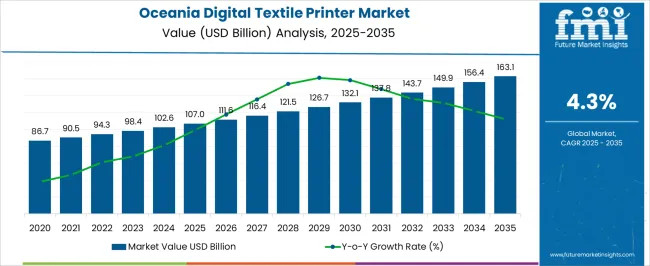
| Metric | Value |
|---|---|
| Oceania Digital Textile Printer Market Estimated Value in (2025 E) | USD 107.0 billion |
| Oceania Digital Textile Printer Market Forecast Value in (2035 F) | USD 163.1 billion |
| Forecast CAGR (2025 to 2035) | 4.3% |
The Oceania digital textile printer market is expanding steadily as demand for customized apparel, home décor, and fashion products rises in the region. The shift toward sustainable, on demand production is driving investments in digital textile printing technologies that minimize waste, reduce water consumption, and enable shorter production cycles.
Brands are increasingly adopting digital solutions to cater to consumer preferences for personalized designs and limited edition collections. Advancements in ink formulations and printer technology are enhancing print quality, color vibrancy, and substrate compatibility, further supporting growth.
Regulatory emphasis on eco friendly production practices and the adoption of automation in textile manufacturing are also accelerating the market’s evolution. The outlook remains positive as both small scale design houses and established manufacturers in Oceania are aligning with digital transformation and sustainability goals to meet the rising demand for fast, flexible, and high quality textile production.
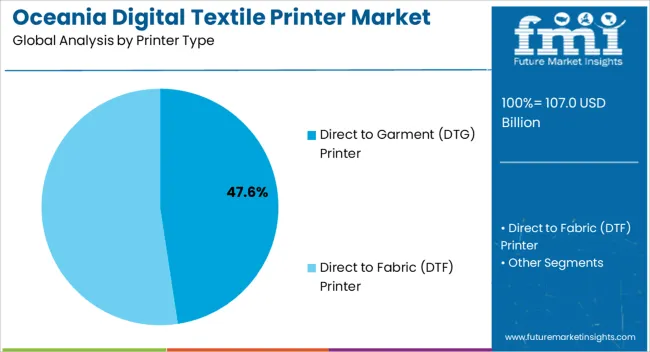
The direct to garment printer type segment is projected to account for 47.60% of total market revenue by 2025 within the printer type category, making it the leading segment. Growth is being driven by the increasing popularity of personalized fashion, small batch production, and e commerce platforms focused on custom apparel.
The technology’s ability to deliver high quality prints directly onto finished garments without requiring transfer processes has enhanced efficiency and design flexibility. Its compatibility with multiple color applications and capability to handle intricate patterns make it a preferred choice for fashion and promotional wear producers.
This combination of quality, efficiency, and customization potential has reinforced its leadership in the printer type segment.
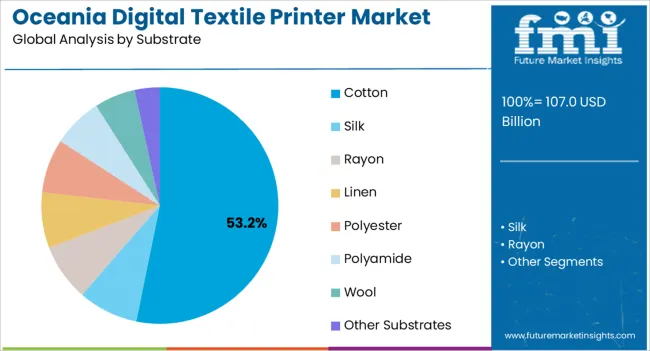
The cotton substrate segment is expected to contribute 53.20% of overall market revenue by 2025, positioning it as the dominant substrate type. Cotton’s widespread use in apparel, comfort wear, and lifestyle products has supported its prominence in digital textile printing.
Its natural absorbency and compatibility with a variety of inks, particularly reactive inks, allow for vibrant and long lasting prints. Consumer preference for breathable and sustainable fabrics has further strengthened cotton’s role in the market.
Additionally, regulatory and sustainability initiatives encouraging natural fiber usage have added momentum to its adoption. The combination of functional performance, consumer appeal, and eco friendly perception ensures cotton’s continued dominance in substrate selection.
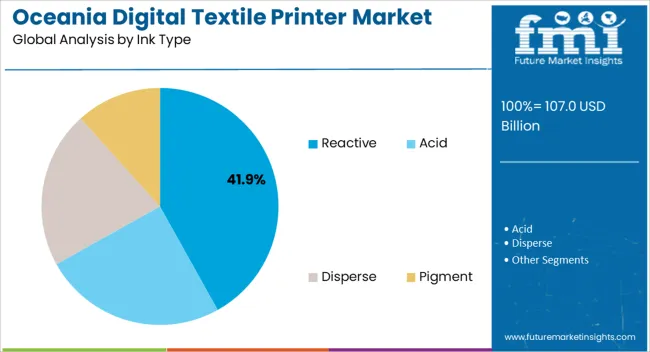
The reactive ink type segment is anticipated to hold 41.90% of total market revenue by 2025 within the ink type category, making it the leading ink choice. This is due to its ability to chemically bond with cellulose based fibers such as cotton, producing prints with superior durability, wash resistance, and color brilliance.
The technology’s compatibility with high speed production processes and eco friendly properties compared to traditional dyeing methods has supported its adoption. Growing demand for long lasting and high quality prints in fashion and home textiles has reinforced the relevance of reactive inks.
With sustainability and performance as key market drivers, reactive inks remain the preferred option in digital textile printing across the Oceania region.
Oceania digital textile printer industry has anticipated a CAGR of 1.8% during the historic period with a market value of USD 107 million in 2025 from USD 86.7 million in 2020.
It is projected that, throughout the forecast period, the market will grow at an accelerated rate. This is due to the growing changes in design elements on textiles made possible by leveraging innovations in the digital textile printing market.
It is further anticipated that the increased use of textile printing in car interior décor and vehicle wrapping will accelerate demand for digital textile printing in the automotive sector.
The market has steadily witnessed a flurry of technological advancements in recent years. Innovations like hot melt printing for textile applications and 3D printing (additive manufacturing) would generate new potential for market growth.
Sustainability concerns have become a crucial determinant for policy decisions, as well as markets worldwide. Moves like reducing water wastage and chemical-free production procedures are the setting the precedent for industries to follow over the coming years.
Digital textile printing being highly environment-friendly when compared to conventional textile printing techniques is expected to remain a key factor contributing to its growth during 2025 to 2035.
Although not a critical concern, fluctuating raw material costs could slow down growth in the market. A few risks associated with digital printing inks might affect children and the elderly population. These could restrain market expansion
Innovations in Fabric Printing Technology to Sustain Digital Textile Printer Sales
Businesses in this market are constantly looking to improve the technology they have at their disposal. Significant R&D investments have become a staple for key manufacturers to be able to diversify their product offerings on the global market.
The companies' main goals are to create printed fabrics using cutting-edge technology and obtain a competitive advantage. The technologies being invested in allow for durable products, and help create goods that have a wide range of applicability.
Printing with eco-solvent, UV, solvent, and aqueous inks has allowed printing operations to inch closer to benefitting the environment. New softwares and programs also offer the advantage of developing novel designs and a wide range of color combinations.
Such programs help improve sharpness and vibrancy of colored textures, which provide for highly visually appealing products. The drive in consumers towards aesthetic fabrics is a key factor expected to propel the Oceania digital printer market.
Eco-friendly Textile Printing Techniques to Present Significant Growth Opportunities for Manufacturers
Compared to conventional printing techniques, digital textile printing technology helps manufacture textiles with less waste, energy use, and chemical additions. Because of this, it is the perfect answer for textile producers who want to lessen their environmental effects and satisfy the rising demand for sustainable textiles.
Compared to conventional printing techniques, digital textile printing is more effective. It enables timely production, reduces waste, and removes the need for huge quantities of printed fabrics.
Digital printing techniques allow for quick turnaround times. This makes it a desirable choice for textile producers who want to boost productivity while lowering their environmental drain.
Digital textile printing technology has the potential to be more economical than conventional printing techniques, as well. It does away with the requirement for printing screens or plates, which can be expensive to make.
This technology enables production of a broad range of colors that match accurately and minimizes the need for color adjustments. Both of these developments significantly lower expenses.

Widening Applications of Digital Textile Printing Will Help New Zealand Maintain Steady Growth
The 2024 Textile and Apparel Market Report for New Zealand, published by the USA Department of Commerce, reveals that demand for digital textile printers is rising there. The production process is becoming more effective and efficient, according to the report, as a result of breakthroughs in digital textile printing technology. This makes it more affordable for New Zealand's textile manufacturers, which are increasingly using digital textile printing as a primary production technique. Several businesses in New Zealand's robust and varied textile sector specialize in everything from high-end clothing to outdoor equipment. This sector is pushing demand for digital textile printing technology to improve productivity, save costs, and keep up with shifting consumer preferences.
| Country | Australia |
|---|---|
| Market Share (2025) | 72.7% |
| Market Share (2035) | 70.3% |
| BPS Analysis | -240 |
| Country | New Zealand |
|---|---|
| Market Share (2025) | 21.3% |
| Market Share (2035) | 22.3% |
| BPS Analysis | 100 |
| Country | Papua New Guinea |
|---|---|
| Market Share (2025) | 3.8% |
| Market Share (2035) | 4.8% |
| BPS Analysis | 100 |
| Country | Fiji |
|---|---|
| Market Share (2025) | 2.2% |
| Market Share (2035) | 2.6% |
| BPS Analysis | 40 |
Massive Domestic Market for Sustainable Textiles has Helped Skyrocket Sales in Australia
Australia has a sizable market for digital textile printers, according to the International Trade Administration 2024 Textile and Apparel Market Report for the nation. Australia has a thriving textile sector with many manufacturers and designers who create a wide range of goods, from high-end clothing to sportswear and household goods. This sector is pushing demand for digital textile printing technology to improve productivity, save costs, and keep up with shifting consumer preferences. The Australian government has offered financial assistance for training programs, business partnerships, and research and development. The industry's expansion and innovation, notably the use of digital textile printing technologies, have been aided by this support.
Cost-effective and On-demand Printing Requirements to Popularize DTF Printers
Direct Fabric Printers (DTF) are likely to remain the majority shareholder in the market based on printer type. It is estimated to capture around 55.1% of the total Oceania digital textile printer industry by 2035-end.
DTF printers can create prints of exceptional quality that have fine details and brilliant colors. A long-lasting print that is resistant to fading and peeling is produced by the printing technique, which enables the ink to infiltrate the cloth deeply.
Cotton, polyester, silk, and many other types of materials can all be printed on with ease using DTF printers. Because of their adaptability, they are a preferred option for textile producers who need to produce a variety of items.
Compared to other types of digital textile printers, DTF printing is a reasonably quick procedure that produces prints of good quality. They are also highly simple to setup and operate. This helps DTF printers be readily available to a variety of textile manufacturers, including small and medium-sized businesses.
Demand for Eco-friendly Printing Solutions to Drive Growth for Reactive Inks
The reactive ink segment is anticipated to reach USD 163.1 Million by the end of 2035 and account for almost 42.6% of the end-use market. Reactive ink is renowned for generating prints of superior caliber that are also sturdy.
Reactive ink is also long-lasting, and provides brilliant colors and outstanding color fastness. Many natural fibers, such as cotton, linen, and silk, can be printed on with reactive ink.
Due to its adaptability, it is the perfect solution for textile producers who need to create a wide range of items. Reactive ink is a well-liked option for textile makers that want to lessen their environmental impact because it is water-based and eco-friendly.
The large color spectrum of reactive ink allows it to produce a variety of hues, including vivid and intense hues. It is also highly preferred for muted as well as pastel tones.
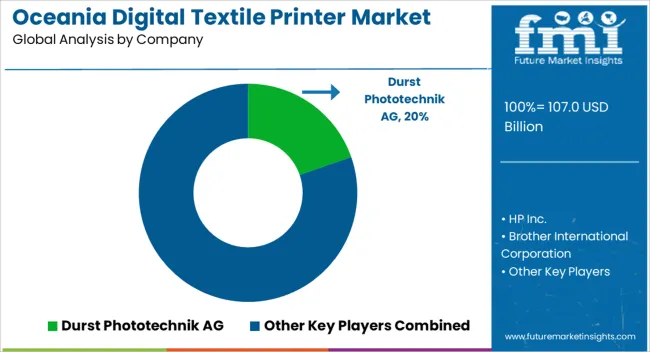
The companies in the market of Oceania digital textile printers are concentrating on developing sustainable solutions and innovations. Concentrating their focus on building sustainable solutions in the textile printing market, product innovations, alongside acquisitions and mergers are key strategies adopted by the players to remain competitive.
Some of the market players featured in the report are HP Inc., Brother International Corporation, Seiko Epson Corporation, Konica Minolta, Inc., Colorjet Group, The M&R Companies, Mimaki Engineering Co., Ltd., Aeoon Technologies GmbH, HGS Machines, Ricoh Company, Ltd. and Electronics for Imaging, Inc., Kornit Digital.
A few recent developments:
| Attribute | Details |
|---|---|
| Growth Rate | CAGR of 4.3% from 2025 to 2035 |
| Base Year for Estimation | 2025 |
| Historical Data | 2020 to 2025 |
| Forecast Period | 2025 to 2035 |
| Quantitative Units | Revenue in USD million, Volume in units and CAGR from 2025 to 2035 |
| Report Coverage | Revenue Forecast, Volume Forecast, Company Ranking, Competitive Landscape, Growth Factors, Trends and Pricing Analysis |
| Segments Covered | Printer Type, Ink, Printer Type (Size), Substrate, Sales Channel, End Use, Country |
| Key Countries Covered | Australia, New Zealand |
| Key Companies Profiled | Durst Phototechnik AG; HP Inc.; Brother International Corporation; Seiko Epson Corporation; Konica Minolta, Inc.; Colorjet Group; The M&R Companies; Mimaki Engineering Co., Ltd.; Aeoon Technologies GmbH; HGS Machines; Ricoh Company, Ltd; Electronics For Imaging, Inc.; Kornit Digital; Tex India Enterprises Pvt Ltd.; Chelsey Chelsey; SMR INDIA PVT. LTD.; DG Prints Fab.; SPGPrints; Arunam Digital Prints; ATPColor; Bordeaux Digital PrintInk Ltd.; Sawgrass Technologies; Jakob Müller Group; Eastman Kodak Company; Dover Corporation; J. Zimmer Maschinenbau GmbH |
The global oceania digital textile printer market is estimated to be valued at USD 107.0 billion in 2025.
The market size for the oceania digital textile printer market is projected to reach USD 163.1 billion by 2035.
The oceania digital textile printer market is expected to grow at a 4.3% CAGR between 2025 and 2035.
The key product types in oceania digital textile printer market are direct to garment (dtg) printer and direct to fabric (dtf) printer.
In terms of substrate, cotton segment to command 53.2% share in the oceania digital textile printer market in 2025.






Our Research Products

The "Full Research Suite" delivers actionable market intel, deep dives on markets or technologies, so clients act faster, cut risk, and unlock growth.

The Leaderboard benchmarks and ranks top vendors, classifying them as Established Leaders, Leading Challengers, or Disruptors & Challengers.

Locates where complements amplify value and substitutes erode it, forecasting net impact by horizon

We deliver granular, decision-grade intel: market sizing, 5-year forecasts, pricing, adoption, usage, revenue, and operational KPIs—plus competitor tracking, regulation, and value chains—across 60 countries broadly.

Spot the shifts before they hit your P&L. We track inflection points, adoption curves, pricing moves, and ecosystem plays to show where demand is heading, why it is changing, and what to do next across high-growth markets and disruptive tech

Real-time reads of user behavior. We track shifting priorities, perceptions of today’s and next-gen services, and provider experience, then pace how fast tech moves from trial to adoption, blending buyer, consumer, and channel inputs with social signals (#WhySwitch, #UX).

Partner with our analyst team to build a custom report designed around your business priorities. From analysing market trends to assessing competitors or crafting bespoke datasets, we tailor insights to your needs.
Supplier Intelligence
Discovery & Profiling
Capacity & Footprint
Performance & Risk
Compliance & Governance
Commercial Readiness
Who Supplies Whom
Scorecards & Shortlists
Playbooks & Docs
Category Intelligence
Definition & Scope
Demand & Use Cases
Cost Drivers
Market Structure
Supply Chain Map
Trade & Policy
Operating Norms
Deliverables
Buyer Intelligence
Account Basics
Spend & Scope
Procurement Model
Vendor Requirements
Terms & Policies
Entry Strategy
Pain Points & Triggers
Outputs
Pricing Analysis
Benchmarks
Trends
Should-Cost
Indexation
Landed Cost
Commercial Terms
Deliverables
Brand Analysis
Positioning & Value Prop
Share & Presence
Customer Evidence
Go-to-Market
Digital & Reputation
Compliance & Trust
KPIs & Gaps
Outputs
Full Research Suite comprises of:
Market outlook & trends analysis
Interviews & case studies
Strategic recommendations
Vendor profiles & capabilities analysis
5-year forecasts
8 regions and 60+ country-level data splits
Market segment data splits
12 months of continuous data updates
DELIVERED AS:
PDF EXCEL ONLINE
Oceania Commercial Ice Machine Market Insights – Growth & Demand Forecast 2025 to 2035
Digital Hall Effect Gaussmeter Market Size and Share Forecast Outlook 2025 to 2035
Digital Group Dining Service Market Size and Share Forecast Outlook 2025 to 2035
Digital Pathology Displays Market Size and Share Forecast Outlook 2025 to 2035
Digital Rights Management Market Size and Share Forecast Outlook 2025 to 2035
Digital Liquid Filling Systems Market Size and Share Forecast Outlook 2025 to 2035
Digital Transformation Industry Analysis in MENA Size and Share Forecast Outlook 2025 to 2035
Digital X-Ray Equipment Market Size and Share Forecast Outlook 2025 to 2035
Digital Marketing Analytics Industry Analysis in Latin America Forecast Outlook 2025 to 2035
Digital Health Market Forecast and Outlook 2025 to 2035
Digital Pen Market Forecast and Outlook 2025 to 2035
Digital X-ray Market Size and Share Forecast Outlook 2025 to 2035
Digital Elevation Model Market Size and Share Forecast Outlook 2025 to 2035
Digital Pump Controller Market Size and Share Forecast Outlook 2025 to 2035
Digital Printing Paper Market Size and Share Forecast Outlook 2025 to 2035
Digital Battlefield Market Size and Share Forecast Outlook 2025 to 2035
Digital Product Passport Software Market Size and Share Forecast Outlook 2025 to 2035
Digital Lending Platform Market Size and Share Forecast Outlook 2025 to 2035
Digital Shipyard Market Size and Share Forecast Outlook 2025 to 2035
Digital Freight Matching Market Size and Share Forecast Outlook 2025 to 2035

Thank you!
You will receive an email from our Business Development Manager. Please be sure to check your SPAM/JUNK folder too.
Chat With
MaRIA